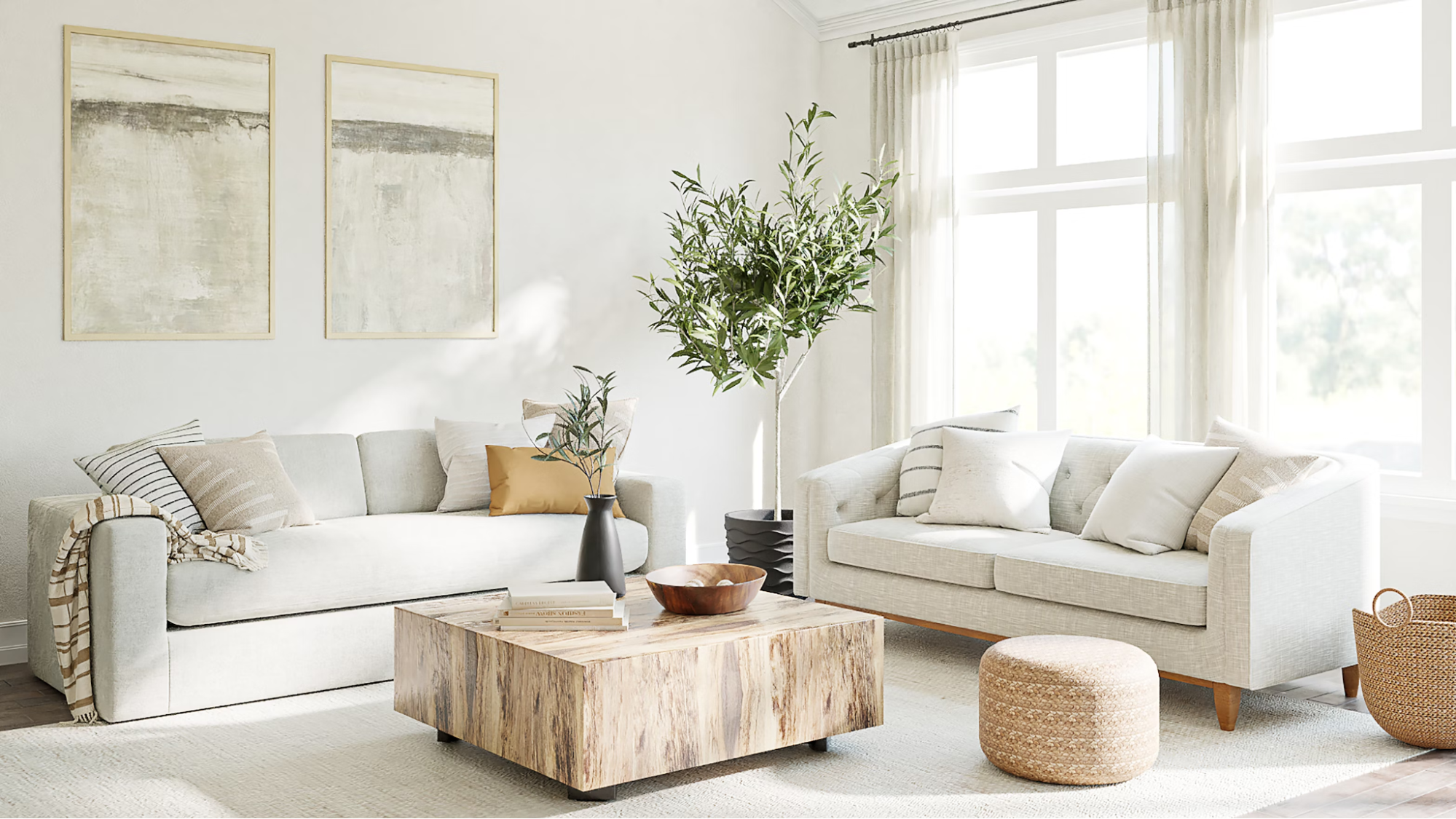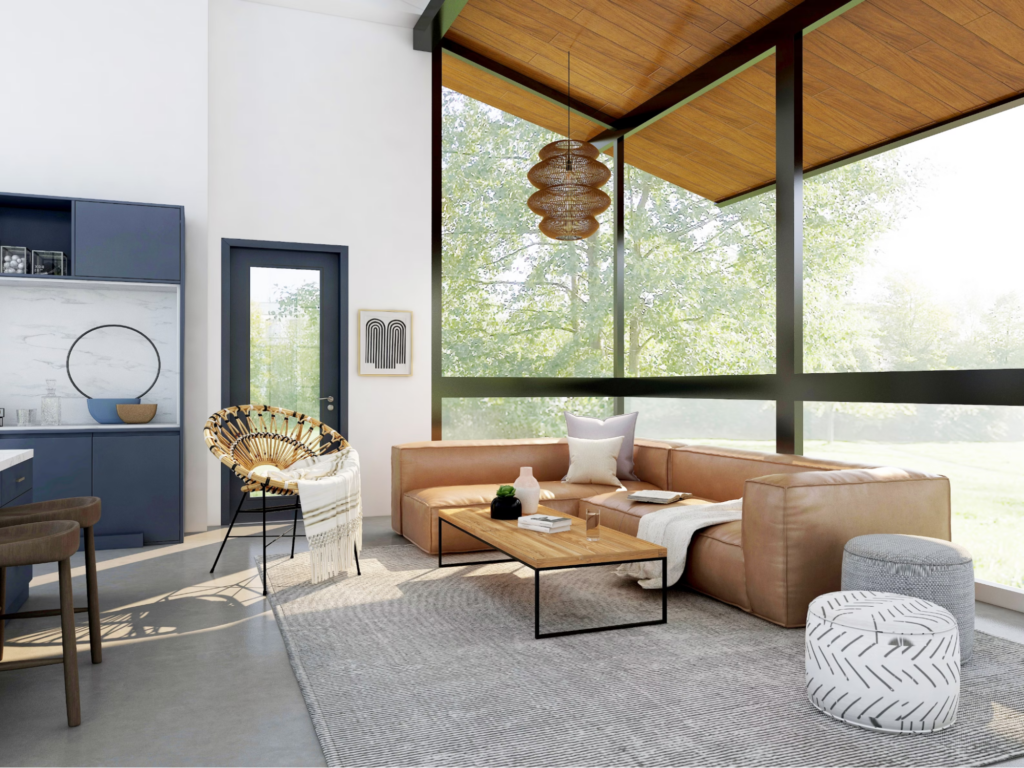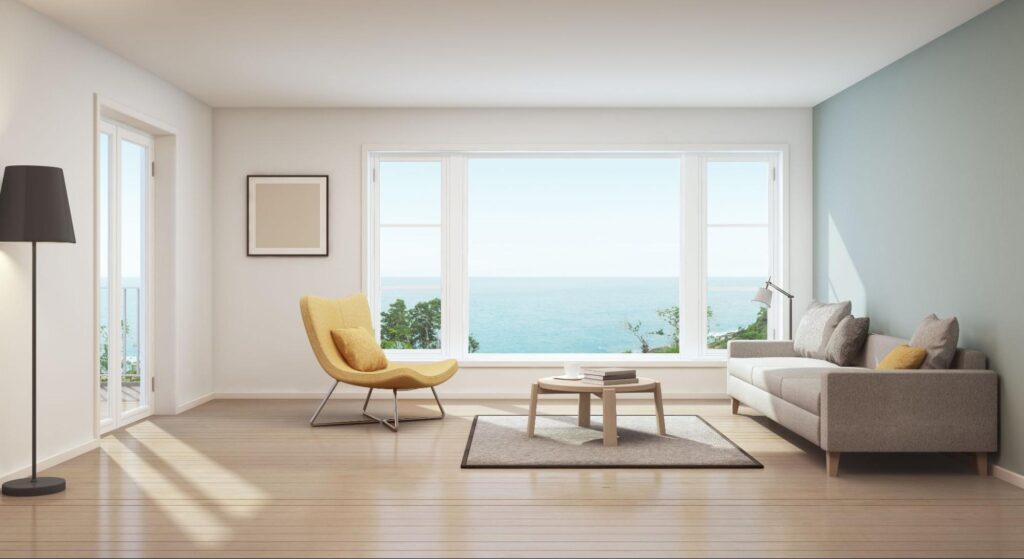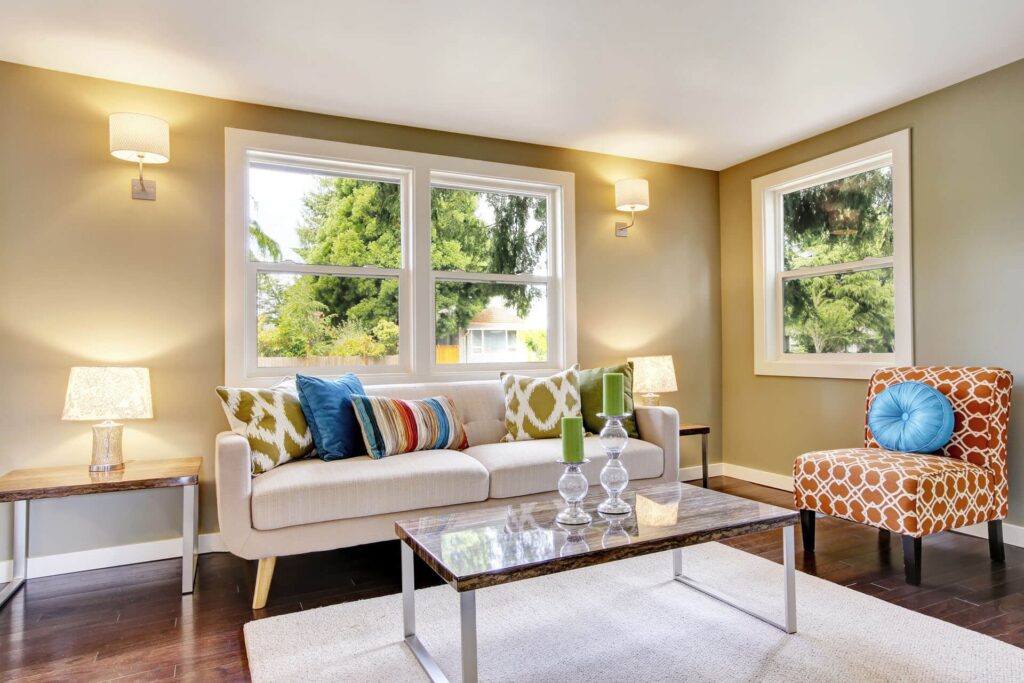
A house with large windows is a perk not everyone can brag about. Yet, what stands out as a unique architectural feature could make interior design a challenge.
Placing furniture in front of a window that takes over the entire room could be a key to balancing the space. However, how can you do that without blocking the natural light and keeping the right proportions?
We’ll explore the best furniture placement for windows that maximize natural light and improve the functionality of your home.
Considerations Before Placing Furniture in Front of Windows
Placing furniture in front of a window is an arithmetic exercise. You have to get the proportions right to ensure the space stays functional and well-lit at the same time. Measuring the dimensions is just one part of the equation. There are a few more aspects to remember before putting furniture in front of a window.
Natural Light
The benefits of bathing your space in abundant levels of sunlight are countless. First, think of natural light as a mood booster. With better vitamin D levels, occupants of well-illuminated spaces are likely to feel happier than those living in darker interiors.
Natural light makes even cramped areas feel more open and airy. If your room is already spacious enough, sunlight can become a strong design statement that speaks for itself.
While styles and trends in interior design change, architects have always integrated large windows into layouts to make the homes as naturally lit as possible. Natural light visually expands interior spaces and is essential for sustainability. With most corners and spaces receiving natural light, the entire space needs less artificial illumination, which reduces energy consumption by up to 20%.
That said, you don’t want to take away any considerable amount of natural light from your windows by blocking them with furniture.
Preserving Your View
When setting up the window area design, ensure the decor elements complement the space without overwhelming it or taking up the view.
If your home has beautiful panoramic views, obstructing them with clunky room decor can feel like a crime. That’s why planning your window area design for functionality and optimal exterior views is critical.
Room Balance
Room balance means focusing on window decor ideas and design principles capable of maximizing natural light. But how do you achieve that?
The simple answer is just to leave your window area design to a minimum. While that can be a great option in some cases, not every indoor space allows for the free arrangement of necessary furniture and decor. If you’re limited in square feet, knowing how to use each practically is a must.
When striving to reach a balance between aesthetics and functionality in your space, think of low-profile furniture. Focus on airy furniture designs that create a single visual plane that opens up the space and brings natural light in. Plus, a fitting color palette and a smart combination of textures go a long way.

Types of Furniture Suitable for Window Areas
You can’t simply put any furniture in front of the window and expect it to work. Some options that usually look best in front of large windows include:
- Sofas: A couch is a focal point of any room, and it takes a lot of space. Consider the size of the sofa to ensure it doesn’t obstruct the light from getting in. Go for a corner sofa if it fits your layout better, or opt for a fair-colored couch to maximize light reflection. If you have enough room, position the sofa at a slight distance from the window wall to achieve the look of floating furniture.
- A window seat: If your room layout allows for a dedicated window seat area, be sure to seize this opportunity. Fill this space with comfy pillows to create a snug spot that leverages the natural light it bathes in.
- A low bookcase: For extra storage, install a handy bookcase under the window. The broader the window, the more space you have to put your favorite literature on display. Consider a custom-made bookshelf for proper integration into your current window area design.
- A coffee table: A small coffee table open to the panoramic scenery of the outdoors is all you can ask for in an urban dwelling. It’s a little escape to enjoy your favorite beverage while soaking in that sunlight.
- Cabinets: Optimize storage by adding some hidden cabinets under the window frame. Go for built-in cabinets that could also serve as a seating area. Opt for color palettes (and finishes) that blend smoothly with the aesthetics of your place.
- Statement armchairs: A comfortable armchair overlooking the view of your floor-to-ceiling window gives a touch of serenity to your day. If your space allows, put a pair of cozy armchairs for an instant conversation den.
- Nightstands: If your bedroom features large windows, consider low-profile nightstands to add some functional storage to your space.
Design Tips for Placing Furniture in Front of a Window
Being intentional with window treatments and furniture positioning is pivotal for a smart interior design. Have a look at the following window furniture arrangement tips to get started:
- Get things measured: Measure the height of the furniture pieces you’d like to position in front of your window. Write down the window sill height. For example, if you’re considering placing a sofa right against your windows, ensure its back doesn’t extend more than a few inches above the sill. If the couch or any other piece of furniture you have in mind goes above the sill considerably, widen its proximity to the window wall. Remember: the higher the furniture piece, the further into the room it goes.
- Follow the ⅔ rule: Place two-thirds of the visual design weight on one side of the room and leave the remaining one-third for the other. For example, place a pair of chunky armchairs and a coffee table against the window wall and balance the furniture distribution by positioning the sofa against the opposite wall. Apply this rule to the color distribution and arrangement of accessories within your space as well.
- Stick to light colors: Lighter furniture pieces and decor elements of softer hues will more effectively reflect the light. An extra benefit: lighter fabrics are less susceptible to fading, so you can enjoy having a nice-looking couch for longer.
- Opt for designs that are both aesthetically fitting and functional: Prioritize versatile design ideas. For example, consider installing built-in cabinets that also offer extra seating space for you and your loved ones to enjoy.

Common Mistakes to Avoid
Getting your furniture placed around the window area the right way means knowing the traps to look out for. Here are some of the most common mistakes you should avoid:
- Mismatched color palettes: Placing a brightly colored sofa in an otherwise muted room can be an effective design choice. However, too many dark tones can make the space feel cramped. Besides, darker hues absorb light instead of reflecting it.
- No greenery: Failing to arrange a complementary set of a few plants and furniture by the windows drains the liveliness from your room.
- Dull-colored drapery: Instead of dark drapes that prevent the light from getting in, opt for sheer curtains to add an intimate touch to the space without obstructing light.
- Furniture too close against the wall: Placing the furniture across the perimeter of your room, leaving too little or no space against the wall, is a common pitfall. Though you free up some space in the center, the trims of your room get cluttered.
Best Rooms to Place Furniture in Front of Windows
The wide range of modern furniture available for window areas allows you to enhance almost any room with pieces that fit both size and aesthetics. Below is a short yet handy list of the most common rooms where placing furniture in front of a window might become an absolute gem of an idea.
- Living room: In most apartment layouts, the living room gets a sizable chunk of space. So, feel free to unleash your creativity when arranging living room furniture near the window. Consider putting a low-profile cushioned bench under the window for a cozy seating area. Another approach would be to put armchairs on both sides of the window for some spatial framing.
- Bedroom. A well-lit bedroom is a key to improving your leisure time. Try to leave the area around the window as open as possible. For extra seating, opt for a pair of slim-looking chairs. Plus, frame the window with sheer curtains for privacy without blocking light.
- Home office: The best home office window furniture ideas maximize natural light to improve the dweller’s productivity. Be strategic when placing furniture in front of a window within your workspace. Position a desk in the area that gets the most natural light to reduce eye strain from artificial fixtures. Place a plant stand there for an extra touch of greenery.
- Kitchen: Put a coffee table near the window to level up your dining experience with more glimpses of light getting in. Complement the setting with a nice pair of comfortable chairs.
Inspiration and Design Ideas
If you find it challenging to envision ways to position furniture in front of a window, start surfing the web for inspiration. You can have a look at our realized projects or find relevant articles on our blog.

How to Optimize Light and Ventilation
The building layout is the primary factor determining how much natural light reaches your living space. If you’re at the planning stage of the construction, it’s worth reflecting on the most feasible ways to welcome natural light. Strategic window placement, skylights, and balconies are great sources of light that generate airflow in the space.
Strategic furniture placement and the proper color palette also affect how well your place welcomes sunlight and retains it. The focal point here is to preserve as much natural light as possible. Ensure the area around the windows isn’t cramped with excessive decor and furniture pieces. Opt for a lighter-colored palette for your interior design to get the maximum amount of light dispersed within the space.
Conclusion
Light sets the tone for comfort and atmosphere in any living space. Thoughtful placement of furniture and decor that maximizes natural lighting is essential. When positioning furniture near windows, follow two key principles: prioritize natural light over excessive decor, and choose lighter interior colors to enhance brightness. Achieving the ideal balance between ample lighting and functional design can be challenging, but it's well worth the effort.
Contact us to get professional assistance and upgrade your windows in your space to the best option!
Frequently Asked Questions
Is it okay to place a sofa in front of a window?
It is absolutely fine to place a sofa in front of a window if it doesn’t block the natural light. Ensure the back of the couch doesn’t extend the window sill by more than a few inches. If it does, bring the sofa slightly further into the room.
How do I choose the right size of furniture for window areas?
To choose the right size of furniture for window areas, measure everything accurately. Start with the window sill and move from there. Ensure the furniture pieces you plan on putting in front of the window don’t extend the window sill more than a few inches.
What is the ⅔ rule for furniture?
The ⅔ rule for furniture is a golden rule for positioning the furniture strategically to achieve aesthetically pleasing proportions. According to this rule, place two-thirds of the furniture pieces within your space on one side of the room and leave the rest for the other.
How to style a bedroom with a bed in front of the window?
If you want to style a bedroom with a bed in front of the window, focus on getting the proportions right. Follow the ⅔ rule to distribute the furniture across the space. If the headboard of your bed extends the window sill by more than a few inches, opt for having it tailored to fit your space.
Can furniture in front of windows reduce energy efficiency?
Yes, placing furniture in front of windows can reduce the energy efficiency of your space by obstructing natural light from getting in. The lack of natural light means you rely on artificial illuminators heavily.
70% off Installation
18 months no interest no payments




